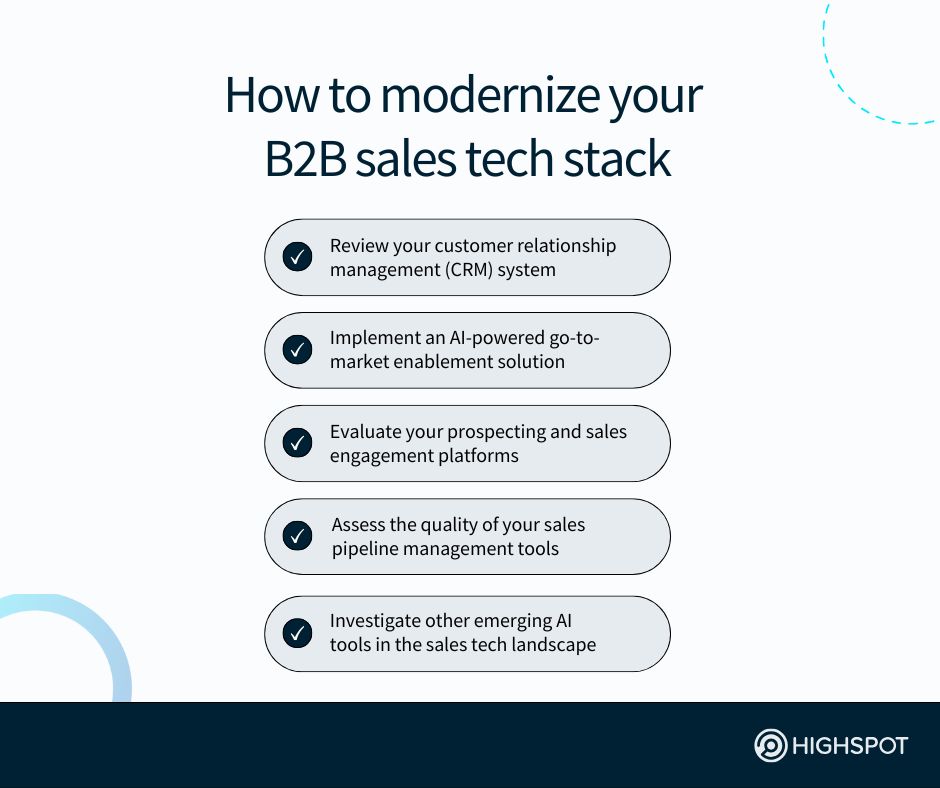Key Takeaways
- A modern sales tech stack isn’t about collecting tools—it’s about aligning them to drive predictable revenue. Choose platforms that simplify, connect, and scale success across teams.
- Focus on how your sales team uses technology, not just what’s purchased. The right balance of AI, automation, and enablement ensures reps spend more time selling, less time searching.
- Regularly audit your sales tech stack to cut clutter, close performance gaps, and prove impact. Stay intentional with every tool so you gain efficiency, consistency, and confidence.
Forrester VP, Principal Analyst Peter Ostrow recently wrote how too many revenue enablement strategies are “focused on tool adoption, believing that their own success depends not on revenue outcomes but on the utilization of tech tools.”
That’s not to say the solutions in your sales tech stack don’t matter.
They absolutely do.
At the same time, though, go-to-market (GTM) leaders such as yourself must also recognize their sales team’s software is a means to an end: platforms intended to drive consistent, scalable revenue and empower reps to thrive daily.
Here’s the truth (one you’re undoubtedly already well-aware of): There’s no such thing as the ‘right’ sales technology stack. Regardless of industry or business model, every enterprise’s digital tool set invariably is different.
What matters isn’t how many apps you’ve bought, but how well they help your sales reps actually sell—whether that’s making it easier for B2B sales teams to navigate a messy selling process, or giving them an edge in closing deals.
Put another way? The modern sales technology stack is less about investing in fancy logos on a slide and more about real, tangible outcomes:
- Can your sales tech help you hit key performance indicators without adding busywork to reps’ already busy plates?
- Do your sales tools help marketing and sales align on how to best engage and convert high-quality leads in your pipeline?
- Do they make your people faster, sharper, and more confident when it matters most?
When developed thoughtfully, your sales software stack doesn’t just support the work of your BDRs and account executives. It also unlocks growth for your entire go-to-market strategy; empowers your enablement, marketing, and sales teams, and fuels scalable, sustainable revenue expansion for your business.
Why a robust sales tech stack is critical
Limitations of legacy sales tools often drive revenue operations leads up a wall.
And for good reason.
Sticking with the status quo—a sales technology stack that fails to deliver the desired ROI, as it relates reps hitting quotas and your go-to-market team at large contributing to revenue acceleration—simply because of comfortability isn’t ideal.
That’s why more GTM leaders are building value-driven business cases for more advanced software tools their sales organizations can leverage to ensure more relevant and timely customer interactions and, ultimately, better close deals.
“But what exactly does an effective sales tech stack look like?”
We’re glad you (well, we) asked.
At the end of the day, your (presumably) expansive ecosystem of sales tools should help you do much more than just efficiently manage leads, merely automate workflows, and tackle some manual tasks. It should also:
Streamline sales forecasting to better predict revenue
Go-to-market leaders—yourself included—live and die by the forecast. Predicting lead generation, flow, behavior, actions, and conversion is paramount to GTM success.
That’s why your organization needs a sales tech stack that makes sales forecasting less of a guessing game and more of a routine, data-driven exercise.
By unifying buyer signals, pipeline data, and seller activity, these tools uncover patterns that would otherwise get lost in spreadsheets. The result? More accurate predictions, stronger planning, and fewer surprises at the end of the quarter.
Just like marketing automation helps marketers stay ahead of campaign results, the right sales automation tools help revenue teams stay ahead of risk.
Layering AI in your tech stack (and strategically—meaning you don’t just onboard the next ‘shiny AI object’) means forecasting isn’t just reactive—it’s predictive.
Ensure GTM and sales productivity continually improves
Every leader at large-scale companies wants to move faster with less friction.
A modern sales tech stack fuels go-to-market efficiency by eliminating silos and automating repetitive tasks—like the dreaded manual data entry so many sales reps fear having to tackle in addition to proactively engaging prospects.
A productivity-enhancing tech stack gives your sales reps get guided workflows, timely recommendations, and clear next steps tied to sales pipeline activities. In turn, they avoid wasting hours hunting for content in a seemingly endless and directionless repository or logging calls and other CRM data.
The sales enablement platform, in particular, is a crucial tech stack addition.
Best-in-class sales enablement software doesn’t just help your reps complete tasks. It also helps them master the sales process. The payoff? Better execution, measurable gains in output, and more time spent on customer engagement.
Facilitate sales performance tracking by rep and team
For your sales managers to coach reps effectively, they need to rely on more than just gut feel. More to the point, they need real-time, valuable insights into every facet of the sales funnel and how sellers engage leads at each sales cycle stage.
A connected sales tech stack—one that syncs your contact management system, enablement solution, lead management software, and other tools impact rep performance—makes it easy to track key metrics at the individual and team level.
That means seeing not just whether deals close, but how reps run their outreach efforts, what content lands, and which behaviors correlate with wins.
With dynamically updated sales dashboards, you and other GTM leaders can spot what’s working, replicate top-performer habits, and give targeted support where it counts.
The outcome is smarter coaching, savvier teams, and better revenue results.

Evolving your B2B sales technology stack
‘Uncertain’ and ‘disruptive’ have been the defining adjectives for the broader business landscape (and global economy at large) over the last few years.
That’s why KPMG Principal, Sales Transformation Lead Walt Becker, writing for Harvard Business Review, said “sales teams must become more agile in how they deploy sellers, engage customers and prospects, and manage sales performance.”
This agility can be best realized by rethinking your sales tech stack.
From determining if they help you build potential-customer relationships, to seeing if you actually gain actionable insights into reps’ sales calls, taking a step back to reexamine the effectiveness of your foundational sales tech—like the tools below—can provide long-term benefits for your sales strategy.
Review your customer relationship management (CRM) system
Your CRM is the memory, map, and motor of your RevOps framework.
If it’s an intuitive contact management tool that enables your reps to connect the dots between their distinct sales engagement efforts and buyer behavior, you’ve got a premier customer relationship management solution.
If it’s clunky, though, everything slows for your sales organization.
Audit how well it captures and connects customer data across the entire sales process. Can reps see clean histories and recent activity and easily discern next steps to take with mid- and late-stage leads? Do handoffs between marketing, SDRs, and AEs feel smooth—or like a baton constantly being dropped?
Legacy contact management systems don’t cut it for modern sales teams. You need a CRM system that’s fast, friendly, and flexible, with tight integrations and rock‑solid governance.
Score your current CRM on adoption (not shelfware), hygiene (no duplicate accounts), and actionability (one click to act). Then, measure how it fuels the rest of your sales tech stack—surfacing context in email, chat, and your seller’s daily workflow.
If your CRM can’t keep up, everything downstream pays the price.
Ideally, your CRM system should be able to merge customer data from across multiple departments. This makes it a whole lot easier for GTM teams to work with prospects or customers, regardless of the department they’re in.
Platforms like HubSpot Sales Hub allow you to merge customer details from across multiple departments within a unified CRM database.
Implement an AI-powered go-to-market enablement solution
This is where you give your whole GTM team—not just sales—superpowers.
Consider Highspot, which runs on our unified AI and analytics engine.
Highspot Nexus™ delivers real-time, robust, AI-powered insights to reps, sales operations, product marketers, enablement personnel, and other go-to-market stakeholders when and where they need it most.
Our software is built to equip, train, guide, and coach your sales force, setting them up for consistent execution. Each rep gets just-in-time guidance, speedy skill development, and the ability to deliver deal-winning content in moments that matter.
With an enablement tech stack built around Highspot, you help your sales team engage confidently in every potential-customer interaction, with recommended plays, content, and next-best actions tailored to the deal and role.
Highspot is the kind of enablement layer that every B2B sales organization needs to scale what works without adding noise. Bonus: Our solution plugs neatly into your sales tech stack, so reps don’t have to toggle or guess—they just sell.
As Highspot’s Essential Revenue Tech Stack guide explains, with a leading, AI-driven enablement platform like ours, “your reps can leverage the right product and marketing content as collateral for selling conversations and supplement asynchronous training with real-time, on-the-job learning.”
Evaluate your prospecting and sales engagement platforms
Your sales prospecting tools should add clarity, not clutter. In other words, they should supply reps with actionable insights into who’s worth pursuing (qualified accounts with high engagement and interest levels, based on CRM data).
Audit how your platforms help reps prioritize leads, reach prospects, and convert buyers without busywork. Are sequences smart—or just spammy? Do they enrich profiles, update records, and log activity automatically?
Strong lead management systems improve sales tracking and give crisp analytics so managers can see what’s resonating by persona, channel, step, and sales cycle stage.
So, look for features that personalize at scale without losing the human touch: intent signals, clean routing, and A/B testing that actually teaches.
(Related: Highspot also enables your entire go-to-market team to see which collateral best resonates with similar sets of prospects so you can double down on the assets that work and ditch the ones that don’t lead to conversions.)
Also, check deliverability, compliance, and how quickly reps can move from insight to action (reply, book, qualify) in one flow. And make sure these tools snap into your sales tech stack so data stays consistent, dashboards stay trustworthy, and your sales reps stay focused on conversations that count.
Assess the quality of your sales pipeline management tools
Bottom line: Your sales pipeline management tools should show where momentum lives—and where it leaks—in your reps’ account-based selling approach.
Can managers spot aging deals, risk signals, and stalled negotiations at a glance? Can sales reps update fields fast, add notes once, and trigger reminders automatically to ensure they reach out to buyers at the right times?
Great systems nudge focus to the few moves that matter this week, not the hundred clicks that don’t. Evaluate filtering, cohorts, and win‑path visualizations that highlight repeatable plays in your pipeline management platform. Then, connect those views to coaching moments, so leaders can assign action, not homework.
Above all, confirm the pipeline layer fits cleanly into your sales tech stack and reflects reality, not wish-casting. If it helps you diagnose, decide, and drive higher sales performance in fewer meetings and shorter timeframes, you’ve got a keeper.
Investigate other emerging AI tools in the sales tech landscape
Once the core is humming, expand with intent.
Consider investing in better contract management software, configure-price-quote (CPQ) solutions, sales call recording tools, sales forecasting software, and competitive intelligence platforms that give you insight into market trends.
However, only buy tools where gaps are obvious and outcomes are clear.
Every addition should shorten cycles, reduce errors, or sharpen decisions.
Vet integrations, permissions, compliance requirements, and admin overhead before you buy. Add‑ons that don’t talk to essential solutions already in your sales tech stack (read: your CRM and GTM enablement platform) create shadow work.
Our advice: Pilot small, prove value, then scale.
Keep a short list of “musts” (security, usability, mobile) and a shorter list of “maybes.” And remember: A tighter sales tech stack beats a taller one.
The goal isn’t more tools—it’s more wins for your sales team with less effort.
Leveraging AI for sales requires a dedicated strategy that clearly indicates how reps and other GTM teams will use the tech and what the expected ROI from using the tools is.
GTM alignment: Important to building a robust tech stack that drives revenue
At the end of the day, if your go-to-market leaders aren’t in sync, your sales process will falter. Building the ‘right’ sales tech stack starts with alignment—across functions, priorities, and outcomes. It’s not just sales and marketing anymore.
Revenue and sales operations own your tech stack, but your VP of Sales, CMO, Enablement Director, and other GTM decision-makers all need a say in the types of sales tools you onboard to ensure strong collaboration across GTM teams.
The point of factoring in these voices isn’t to end up with too many cooks in the kitchen and tool sprawl. It’s about ensuring GTM coordination and orchestration.
When you collectively factor in revenue-growth targets at the start sales tech stack configuration journey, you stop chasing shiny tools and start choosing ones—notably, AI solutions—that can help close your go-to-market performance gap.
So, take the time to evaluate your options, run a demo or two, and get your buying committee to agree on which other tools actually matter.
Then, build an AI-forward GTM tech stack that can scale with you—because AI that’s ‘bolted on’ is a gimmick, but AI built in from the start transforms how teams work for the better.
Remember: Closing deals isn’t the finish line. Repeatable execution is.
The objective is to hit your numbers, scale success, and keep your sales machine running smoothly quarter after quarter. Alignment gives you leverage, helps you gain new efficiencies, and eliminate existing inefficiencies in your workflows.
Driving top-performer execution is the goal. Everything else is just noise. Keep that in mind when building your sales tech stack, and you’ll put your entire sales team on a better path to predictable, sustainable success.
Your sales tech stack FAQs, answered
You now know the best sales tools to buy and how to work as a team to investigate and onboard them—but we know you have other questions too. Here are some we regularly hear from GTM leaders about sales tech stack development.
What tools should my sales and marketing teams both work in?
Sales and marketing teams should share content management, CRM, and analytics platforms so customer data flows seamlessly. This ensures consistent messaging, smoother handoffs, and a unified view of pipeline impact.
How should I balance AI and automation use in my sales tech?
Lean on AI solutions for customer-interaction insights, sales coaching, and content recommendations, and use automation for admin and task routing. Balance means reps sell more, while the tech runs quietly in the background.
Which sales software most directly impacts revenue growth?
Your sales enablement, CRM, and pipeline management tools directly tie your sellers’ actions to business outcomes. These solutions give go-to-market leaders visibility, help reps execute consistently, and accelerate sales velocity.
Where should I look to improve my existing sales tech stack?
Start with redundancies, as multiple tools doing the same job deter sales rep adoption and achieving your desired ROI. Then, target gaps in analytics, AI, and go-to-market enablement that keep you from proving impact on revenue.
How can I track sales technology stack utilization by my reps?
Use platform-level analytics, adoption dashboards, and sales scorecards to see who’s using what sales software and how often. Pair that data with outcome metrics, like deals closed, to prove software utilization equals impact.
Which AI tools do modern sales teams trust the most today?
Many B2B sales teams favor artificial intelligence built natively into sales enablement and CRM platforms because it connects context to action. Point solutions can help, but integrated AI delivers accurate, scalable impact.
What kinds of sales productivity tools should we invest in?
Invest in sales tools that cut the amount of time that reps spend searching, logging, or guessing, such as sales enablement platforms, AI sales assistants, and automated content creation tools. The goal is less admin, more selling.
How often should sales leaders audit their technology stack?
Review your sales tech stack twice a year to ensure strong adoption and alignment to revenue goals. Rapid shifts in artificial intelligence for sales mean that the longer you take to modify your tech ecosystem, the more at risk your business is of falling behind competitors.




